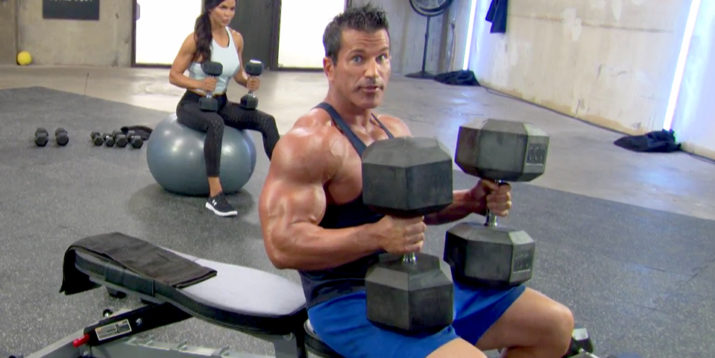5-Day Workout Routine: What You Need to Know

You’ve seen them in the gym: the grinders. They don’t just work their muscles — they pound them, set after set, laying waste to every fiber with any tool they can find, from barbells and dumbbells to bands and bodyweight. Instead of working the whole body 3 or 4 days a week, they follow a 5-day workout split, annihilating each body part just once or twice every 7 days.
Madness? Maybe. Sagi Kalev, the bodybuilder and Super Trainer behind Beachbody’s 5-day workout routine A Week of Hard Labor (AWOHL) is certainly no fan of moderation.
But there are advantages to going off the reservation now and then. And if bigger muscles are your primary goal, a “split system” approach — the technical term for working just one or two muscle groups per workout — can be a powerful weapon in your mass-building arsenal.
Why Do a 5-Day Workout Split?
Aside from an overabundance of free time and a fondness for post-workout soreness, why might you want to become a grinder — at least temporarily?
As we’ve covered elsewhere, muscle growth, or hypertrophy, is caused by three factors: muscle tension, metabolic stress, and muscle damage. To make a muscle grow, science tells us you need to:
- Contract it (that’s the tension part)
- Work it long enough to make it burn (that’s the stress part)
- Do all of this hard and often enough to stimulate repair (that’s the damage part)
A 5-day workout routine does all these things. Here’s how:
1. Greater total volume
Consider the weekly workout volume (number of sets per muscle group) of a full-body program and a 5-day program.
The total-body exerciser might hit his chest with 3 sets of bench presses on Monday, 4 sets of incline dumbbell presses Wednesday, and 2 sets of pushups on Friday. That would put his weekly volume of chest work at 9 sets.
The split-routine exerciser, on the other hand, might do 15 or more sets for chest in a single day. If he includes an additional full-body workout 1 day a week (as is the case in A Week of Hard Labor), he’ll squeeze in another 3 or 4 sets, bringing his weekly volume up to a whopping 19 sets — more than twice that of the total-body exerciser.
Additional volume means more tension, more stress, more damage — more of all the factors that lead to muscle growth.
You don’t want to dive into an advanced program like AWOHL without at least a few months of training behind you. But assuming you’re not a complete beginner, and that your rest and nutrition are on point, all that additional stimulus can translate into greater growth.
2. Increased blood flow
One side effect of higher-volume training, particularly when you perform 10 or more reps per set, is that large amounts of blood rush into your working muscles to supply them with oxygen. This does more than make you look momentarily buff-er; it’s also a powerful stimulus for growth.
What gym rats call “the pump” is known to researchers as cellular swelling, and it happens because muscular contraction prevents blood from flowing out of your muscles while your arteries continue to pump it in. The effect is like damming up a rushing river: liquid pools in one spot without a place to go.
Studies have shown that engorging a muscle with blood in this way stimulates protein synthesis (muscle growth) while inhibiting muscle breakdown — the perfect recipe when you’re looking to build more muscle.
3. More rest
It sounds like an oxymoron: How could a program with five workouts a week afford you more rest than a more conventional 3- or 4-day-a-week regimen?
That’s the key to the split approach: Although workout frequency is high, and each workout is involved and intense, you still get at least 2 days’ rest between workouts for a given muscle group.
Taking A Week of Hard Labor as an example, you work your legs by themselves on day 2 and don’t hit them again until day 5. That gives them 2 full days to recover before you hit them again, then 3 more days after that before you repeat leg day. That’s substantially more rest than you get for each muscle group in a full-body program, in which you might hit each muscle group three to four times a week with only about a day between sessions.
4. Laser focus
When your goal is hypertrophy, sometimes it’s valuable to hone in on that goal at the expense of all others (e.g., strength, power, muscular endurance, etc.).
A 5-day workout split is perfect for that: You don’t need to squeeze in a cardio workout on your off days. You won’t be too tired from working your legs to train you arms (you’ll train them on different days). You won’t worry about burning a ton of fat or maintaining your speed in the 40-yard-dash. Instead, you’ll bring all your physical and mental energy to hammering your muscles and forcing them to grow like crazy.
How Should You Split Your Workouts?

The most obvious factor to consider when building a 5-day workout routine is your schedule. If your Wednesday is busy and stressful, make it a rest day. If Fridays are low-stress for you, schedule a longer, tougher workout.
In general, you’ll want to work out for 3 days before your first rest day, then 2 more days before your second one (so if Monday is your “day 1,” Thursday and Sunday are rest days). This isn’t set in stone; some weeks, life will force you to rest on different days — and that’s OK. Since you aren’t working the same muscle groups 2 days in a row, you’ll still get all of the rest you need.
What Muscle Groups Should You Work Out Together?
For “antagonistic” muscles — those that perform opposing actions, like chest vs. back, biceps vs. triceps, quads vs. hamstrings — it makes sense to train them on the same day. But you can also effectively train your “pulling” muscles (back and biceps) on one day and your “pushing” muscles (chest and triceps) on another, since these muscle groups usually work together anyway. AWOHL treats the core like any other muscle group, assigning it its own day rather than making it an “add-on” somewhere else.
One of the more innovative aspects of Kalev’s program is its inclusion of one total-body day — a workout in which you hit every major muscle group. The result, says Trevor Thieme, C.S.C.S., is that you work each body part twice a week instead of once.
“In so doing,” he says, “you double the frequency of the growth stimulus to each muscle group each week. And because of how the workouts are arranged, you do that without negatively impacting your recovery.”
Some options:
Option 1* |
Option 2 |
Option 3 |
| Day 1: Chest, back | Day 1: Chest, shoulders, triceps | Day 1: Back, hamstrings, glutes |
| Day 2: Legs | Day 2: Legs | Day 2: Core |
| Day 3: Core | Day 3: Back, biceps | Day 3: Chest, quads |
| Day 4: Shoulders, biceps/triceps | Day 4: Core | Day 4: Shoulders, biceps/triceps |
| Day 5: Full body | Day 5: Full body | Day 5: Full body |
*This schedule is used on AWOL.
7 Essential Ingredients of a Split Workout
The sessions in your 5-day workout routine will be intense, but relatively short. All of the workouts in Kalev’s program average less than 45 minutes, warm-up included. The goal: to work each muscle safely but intensely, using the most challenging weights that allow you to complete all of your reps and sets with good form.
In AWOHL, “The workouts feature lifting techniques that increase your training density and your muscles’ time under tension, as well as allow you to more completely fatigue your muscles,” says Thieme. “As a result, they optimize your training stimulus, helping you build bigger, stronger muscles faster.”
Some of those techniques include:
1. Varied set/rep schemes
Muscles are comprised primarily of two kinds of fibers: type I and type II, which, broadly speaking, are responsible for high-rep, low-resistance movements and low-rep, high-resistance ones, respectively. To force your muscles to grow optimally, AWOHL includes higher-rep moves (like push-ups performed for 3 sets of 15 reps) to hit your type I fibers and lower-rep moves (like heavy dumbbell presses, performed for 4 sets of 6), to hit your type IIs.
2. Compound movements
Moves like lunges, squats, and pull-ups involve the movement of multiple joints and thus work multiple muscles, allowing you to lift heavier weights, generate more tension, and generally get more bang for your muscle-building buck.
3. Isolation exercises
Dumbbell curls, triceps extensions, lateral raises, and other single-joint movements help you target smaller muscles, allowing you to focus more intensely on muscles that usually play a supporting role.
4. Supersets
This term refers to performing back-to-back sets of two different exercises. You can alternate between exercises that target opposing muscle groups (e.g., bench press and bent-over row), non-competing muscle groups (e.g., overhead press and deadlift), or, more diabolically, the same muscle group (e.g., squats and lunges). If you add a third exercise (e.g., bench press, row, and lunge), it’s called a tri-set.
5. Circuit sets
These typically involve back-to-back sets of four or more exercises with minimal rest between them (usually, just the time it takes you to transition from one to another). By extending the duration of uninterrupted work, you’ll fatigue your muscles even faster and more completely.
6. Drop sets
In this set scheme, you perform 3 or 4 sets of an exercise without rest, using a slightly lighter weight for each one. Also called descending or strip sets, they can also be performed by switching a heavier weight for a lighter one at the end of a set to squeeze out a few more reps.
7. Eccentric training
Research shows that focusing on the lowering phase of an exercise (i.e., by performing it more slowly than the lifting phase) can help maximize muscle growth. But prepare to be sore: This technique also increases muscle damage (don’t worry — that’s a good thing in the context of muscle building).
One to Grow (Muscle) On
With so much volume, so many different moves, and so many advanced techniques coming at them, your muscles will have no choice but to grow like crazy. Want to build some size? Grinding through a 5-day workout split may be just the methodical madness you need.
